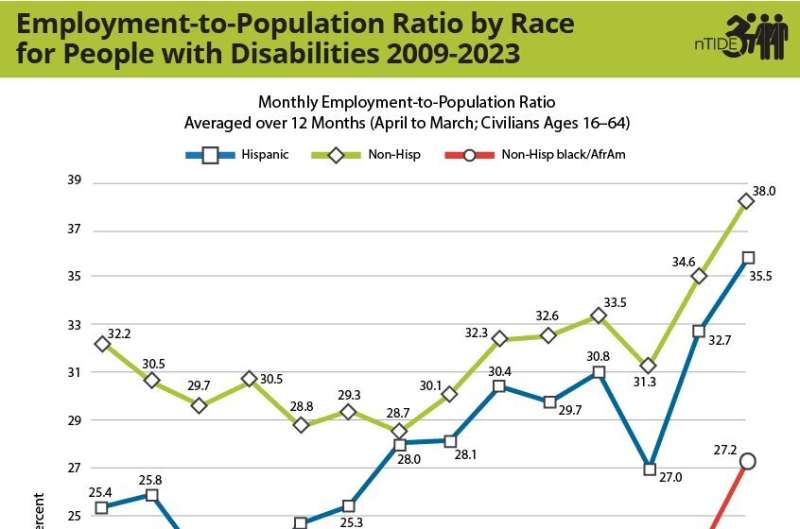This article has been reviewed according to Science X's editorial process and policies. Editors have highlighted the following attributes while ensuring the content's credibility:
fact-checked
proofread
Hispanics with disabilities making historic rebound in job market post-COVID-19 shutdown

New data shows that Hispanics with disabilities in the United States rebounded to historic levels in the labor force following the first 12-month period of the COVID-19 pandemic. While the disparity between their non-Hispanic white counterparts remains, their recovery has narrowed this gap and surpassed that of their Black/African American counterparts, according to experts speaking during a recent nTIDE Deeper Dive Lunch & Learn Webinar.
To further improve employment opportunities for Hispanics with disabilities, experts also reviewed measures that address social determinants of health, education, and language barriers that disproportionately impact Hispanic communities.
Using data from the U.S. Bureau of Labor Statistics (BLS) for persons ages 16-64, the monthly employment-to-population ratio averaged over the 12-month period, April 2022-March 2023, was 35.5% for Hispanic civilians with disabilities, compared to 38.0% for non-Hispanic white civilians with disabilities. However, estimates of 27.2% for non-Hispanic Black/African Americans with disabilities indicate that this group has not rebounded as strongly as Hispanic and non-Hispanic white civilians with disabilities.
In contrast, the average monthly employment-to-population ratio was 71.8% for Hispanic civilians without disabilities, compared to 77.0% for non-Hispanic white civilians without disabilities in the same period. The monthly employment-to-population ratio, a key indicator, reflects the number of people in a population who are working, relative to the total number of people in that population. A 12-month average of this indicator is used to boost statistical precision. The 12-month period of April in one year to March in the next year is used to help examine employment trends before and after the COVID-19 pandemic lockdown recession.
"Among people with disabilities, each group has recovered but not at the same rate. Breaking out segment estimates of Hispanic, non-Hispanic white, and non-Hispanic Black/African Americans with disabilities shows a compelling story," summarized nTIDE expert Andrew Houtenville, Ph.D., professor of economics at the University of Hampshire (UNH) and research director of the UNH Institute on Disability.
"Overall, we have seen a strong rebound in the job market for Hispanics with disabilities, reaching historic highs since bouncing back from the pandemic lockdown. Yet, there is still a substantial gap between Hispanic and non-Hispanic white civilians," he added. "Non-Hispanic Black/African Americans with disabilities were slower to recover in April 2021-March 2022, but have since picked up ground over the past 12 months," he added.
Disparities still remain
Even with the latest employment-to-population ratio rally among Hispanics with disabilities, this group still faces barriers in accessing quality jobs due to language, cultural differences, and social determinants of health, according to Javier Robles, director of the Center for Disability Sports, Health and Wellness at Rutgers University and co-chair of the Rutgers University Disability Studies committee.
"We are talking about a varied population with many different cultures and languages," said Robles. Additional focus on providing tailored support and resources for Hispanic individuals with disabilities can help them access the programs and systems designed to reduce employment barriers, he added. These measures should emphasize promoting access to Spanish-language materials, addressing health disparities, and challenging societal attitudes towards disabilities in the Hispanic community.
"In addition, businesses need to understand the cultural aspects of hiring individuals from Latino cultures, particularly in the context of respect. In our culture, there is a deep respect for authority. A Latino with disabilities may not ask for an accommodation because they feel such a request questions that authority," Robles asserted. Addressing these underlying factors will help close the disability employment gap and create a more equitable workforce for all individuals.
Data collection and language
When presenting information about race, nTIDE employs the terminology found in the survey that serves as the basis for BLS data, known as the Current Population Survey (CPS). Participants in the survey were asked to select one or multiple race categories from the following five options: White; Black or African American; American Indian or Alaska Native; Asian; and Native Hawaiian or other Pacific Islander. Separately, participants are asked whether they are of Hispanic origin.
The statistics presented in the nTIDE Deeper Dive represent participants who specifically indicated being of Hispanic origin; non-Hispanic origin and white only; and non-Hispanic origin and Black/African American only. Respondents who chose more than one race category were not included in these calculations. Statistics for other categories are available upon request and may be the subject of future nTIDE Deeper Dives. The questionnaire may be found at the following link.
Provided by Kessler Foundation





















